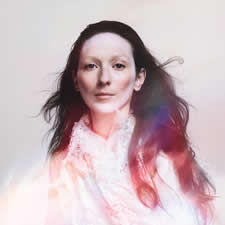Overheard chatter from students revealed that they had had heavy hints from their wise faculty members that they’d better attend the first concert in this season’s UNCG Artist Faculty Chamber Series, presented on September 19 in the superb Recital Hall of the School of Music. The centerpiece of the program, given under the umbrella of “Moonstruck,” was Arnold Schoenberg’s Pierrot lunaire , Op. 21, one of the most seminal and forward-looking works of the twentieth century. It is often written and talked about but very seldom performed. A query of fellow CVNC writers turned up only two regional performances, both by the Mallarmé Chamber Players. One was early in their history with the late Allan Bone on clarinet, and the other was in the spring of 2001, with Penelope Jensen delivering the original German text.
In his fine essay that accompanied the classic Jan DeGaetani recording (on Nonesuch), Charles Wuorinen wrote, “not only must every literate listener know Pierrot lunaire and come to terms with it; every composer must deal with it.” Stravinsky likened it to “the solar plexus as well as the mind of early Twentieth Century music”; recalling an early performance, he called it “the most prescient confrontation in [his] life.” These “Thrice Seven Poems from Albert Giraud’s Pierrot lunaire ” were composed with contextual atonality, which Schoenberg abandoned after he developed his rigorous 12-tone system. The text, originally in French, was set to a German translation by Otto Hartleben. An important early commission, the work was intended to be declaimed by the patron, actress Albertine Zehme. The composer left sphinx-like directions about how the text was to be delivered in “Sprechgesang” (or “Sprechstimme”), more a type of heightened speech or melodrama than song. No two who recite this text seem to make the same choices from the composer’s ambiguous and contradictory directions. I remember the 2001 MCP performance as being more sung than spoken.
The UNCG performance made an excellent case for honoring Schoenberg’s wish that Pierrot lunaire be performed in the language of the audience. Attempting to follow both the original German text and a fairly literal line-by-line translation leads to an atmosphere somewhere between receiving the last rites or a dose of bitter medicine. The far-from-obvious relationship between the melodramatic delivery and the complex variation of the eight supporting instruments (played, usually, by five musicians, although six were present here) can lead the novice listener to feel like he (or she) is undergoing squeaky chalk on a blackboard. Use of the vernacular opens the composer’s intended parodies and ironies. With clear diction and an ideal blend of heightened speech and melodrama, Carla Le Fevre was splendid in her delivery of the text. Ensemble was closely controlled by conductor Welborn Young. The familiar UNCG faculty musicians were Kelly Burke, clarinet and bass clarinet, Deborah Egekvist, flute and piccolo, GSO Concertmaster John Fadial, violin, pianist Andrew Willis, and – a casting luxury since it is used so briefly – the viola, here played by Scott Rawls. UNCG’s new cellist, Brooks Whitehouse, rounded out the ensemble. All did a fine job of bringing off the composer’s difficult effects, and all deserved the multiple curtain calls for this Everest of modern music, still cutting-edge despite its 1912 birthdate.
Since the text of Pierrot lunaire drew upon the characters from the world of “commedia dell’arte,” with its stock characters (Harlequin, Pierrot, Pulcinella, Scaramouche, et al), together with images of the Moon, the first half of the program kept with those themes. Soprano Ellen Linton, well accompanied by pianist Andrew Harley, sang four Franz Schubert songs haunted by moonlight: “Der Wanderer an den Mond,” “An den Mond,” “Abendbilder,” and “Erntelied.” Her voice was evenly supported throughout its range, and her stage deportment was a lesson to those who use an awkward set of semaphore signals or are indecisively restlessness. Her high notes were firm, but her dynamics needed more variety. Harley, with the piano lid on its short stick, phrased with sensitivity.
An early cellist may be responsible for the myth that associates “Pierrot arguing with the Moon” with Debussy’s Sonata for cello and piano, which was also played. The stage was radically reset, with the piano keyboard at a 135-degree angle to the stage and cellist Whitehouse seated to the left of the pianist with only stage behind him. He produced a rich dark tone from his instrument and had intonation and phrasing under positive control. A broken string led to a restart of part of the piece; he repeated enough of the earlier material to recapture the mood. For this work, Harley played with the piano lid fully up and with balances perfect except for a fleeting moment. The full palette of piano colors was projected.
Many UNCG concerts have useful commentaries placing the music in historical and cultural context. Music historian Elizabeth L. Keathley tied this “Moonstruck” program together nicely by alluding to the political and aesthetic aspects of Biedermeier society and its effects upon Schubert and his circle. She exposed the doubtful Pierrot myth attached to the Debussy. Considerable background was given on the Schoenberg. The composer was hung up on numerology and feared the number 13, perhaps with some justification: he was born on the 13th day of September (1874) and died on the 13th day of July (1954). The role of cabaret and the performance tradition of “diseuses,” sort of one-woman shows or melodramatic monologues as they related to Op. 21’s birth, were mentioned. Keathley also touched on the composer’s intention to satirize the nineteenth century’s attitude toward art as a high or religious experience.











